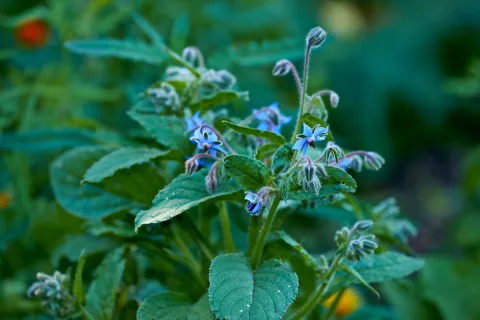
Scientific Name
Borago officinalis
General Information
Borage is an exuberant annual that grows two to three feet tall and is covered with many striking blue pendulous flowers. It is a prolific self-seeder and may become invasive.
When to Plant
Sow in late spring to early fall.
Thin so mature plants stand a foot or two apart.
Planting
Seed in place in March and April. Borage does not transplant well.
Can be container grown. Be aware that it will self-seed.
Full or nearly full sun.
Soil Requirements
Not fussy about soil. May not grow quite as tall in poorer soil.
Water Requirements
Keep plants evenly moist.
Fertilizing
Feed monthly with a balanced organic fertilizer at half the recommended rate.
Pollination
Loved by pollinators!
A favorite of honey bees but also attracts bumble bees and small, native bees.
Harvesting
Tastes mildly of cucumber.
Harvest in the morning after dew dries but before the sun gets hot to retain the distinctive flavor.
Use only young, tender leaves. As the leaves mature they become quite hairy.
Eat flowers with or without fuzzy sepals. Remove sepals by pulling on stamens.
Use both leaves and flowers in salad. The blooming tops and leaves can be steeped in boiling water for tea.
As a garnish, the flowers can be floated in iced tea or punch, or they can be candied for use on baked goods.
Makes an attractive cut flower in bouquets.
Storage
Best if used when fresh.
Flowers can be frozen with water in ice cube trays to add to drinks.
Good Varieties for Marin
Common borage (pictured above) is the most familiar.
There is also a variegated variety with a more subtle blue flower and green leaves mottled with white.
Borage officinalis ‘Alba’ is a variety with white flowers.
Creeping borage sprawls and is a short-lived perennial.
Helpful Tips
While edible, this plant also attracts bees that pollinate other plants encouraging pollination of other plants in your garden.
If planted in a container, you can move the plant around the garden to encourage bees where needed.
Borage is a prolific self-seeder, which means you will likely always have some in your garden after planting just once.
As with all herbs start by consuming sparingly to be certain it can be tolerated.
Common Problems
If self-seeding produces too many plants or in undesirable places, volunteers are easily pulled. Wear gloves since stalks are
Deadheading can prevent volunteers and encourage continuous bloom.
Pests- Diseases & More
Not generally bothered by pests.
Can be affected by mildew if there is not sufficient spacing to allow for air circulation.

